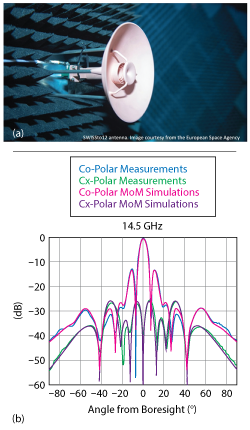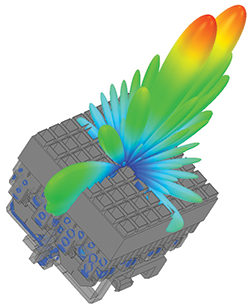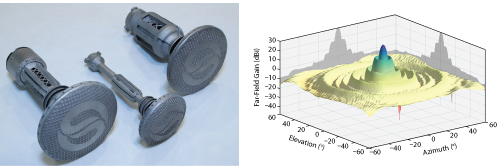Traditional antenna technology has hit its limits in many demanding commercial and aerospace markets such as 5G, SATCOM, IoT and radar. But there are many companies developing new approaches and materials that could drastically improve antenna performance and enable new applications that were not previously envisioned because of these limitations. In this article, Microwave Journal looks at a sampling of these technologies that have come to our attention in the last couple of years.
3D Printed Antennas
Recent advances in 3D printing or additive manufacturing have enabled complex RF structures to be realized. The characterization of the materials used in 3D printing processes has been shown to be critical in designing and accurately predicting the performance of these structures. Understanding the RF properties of the materials through characterization has led to the development of novel structures that could not ever be realized with traditional manufacturing techniques. 3D printing has also allowed manufacturers to produce traditional antenna shapes with less weight and at a lower cost.
SWISSto12 SA is an offshoot from the Swiss Federal Institute of Technology in Lausanne, Switzerland. The company has developed unique products using 3D printing that are based on polymer materials that are then metal plated or on metallic materials (such as aluminum or titanium) combined with advanced surface treatments and surface plating. Using these processes, SWISSto12 manufactures and tests aerospace qualified advanced RF products such as waveguides, filters, beamforming networks, antenna feed chains or array antennas.

Figure 1 Swissto12 Ku-Band dual-reflector antenna (a) image courtesy of the ESA, and the radiation properties over the design frequency range (b).
Their use of 3D printing allows for increased flexibility in the manufacturing of complex product designs. This freedom can be used to produce higher complexity RF components, which often allows for better RF performance. Traditional machining technologies used to manufacture RF products are limited in their ability to produce products with complex shapes. To circumvent this limitation, complex products are often assembled out of a larger number of simpler sub-components that are produced separately. SWISSto12’s 3D printing technology does not have such constraints, allowing it to produce entire products in one single element that positively impact mass, cost, lead time, assembly quality and RF performance. The use of 3D printing also allows for optimized weight reduction. The technology has been demonstrated on waveguide, filter and antenna components from C- to W-Band (4 to 110 GHz).
As this technology is rapidly gaining maturity and acceptance among the aerospace industry, SWISSto12 has already delivered a variety of prototypes to organizations in the space and SATCOM industries that have been qualified for use in airborne and space environments (the first commercial programs will be flying SWISSto12 products in 2018). More complex and integrated antenna or payload structures are in development, in particular Ku- and Ka-Band products. The company is also targeting emerging market opportunities such as high-altitude platforms, UAVs and Cubesat constellations. An example antenna product is a Ku-Band dual-reflector antenna comprising a conical chocked horn, a sub-reflector, a main reflector and metallic supports. This antenna system only weighs 145 g. The radiation properties of this antenna were found to be in an excellent agreement with simulation results over the design frequency range (see Figure 1). This antenna demonstrator was manufactured and tested in collaboration with the European Space Agency.

Figure 2 Optisys Ka-Band 16-element tracking array with measured and simulated data.

Figure 3 Optisys Ka-Band 64-element tracking array with signal pattern.
Optisys is another company that focuses on the design, fabrication and test of lightweight antennas using metal 3D printing. The specific method that Optisys uses for fabrication is a powder bed fusion process, where thin layers of powder are welded into solid metal by a high-power laser. Through this welding process, a part is built one small layer at a time. This green manufacturing process allows for material to be added only where absolutely necessary to achieve a given mechanical or RF function.
As with any fabrication process, 3D printing has a set of design rules that determines what can and cannot be included in a design. Optisys is reimagining how waveguide is routed to achieve a desired RF function to take full advantage of the strengths of the printing process that allows, in some cases, for over an order-of-magnitude reduction in the size and weight of an antenna. Along with size and weight, part count reductions and absorbing tolerance stack-up can lead to simpler antenna assemblies with improved performance.
Optisys has designed a number of arrays using building blocks developed in-house that are rearranged and optimized for different functions and frequency bands. One of the key antenna designs is a Ka-Band 16-element tracking array shown in Figure 2. Signal patterns show the sum and delta elevation performance with measured and simulated performance overlaid. This part includes a 16-element array of horns that are circularly polarized, with a waveguide combiner network on both left- and right-hand circular polarizations. Additionally, the right- hand combiner network feeds into a dual-axis monopulse comparator. All of this is implemented in a single part that weighs less than 2 oz and fits in the palm of the hand.
A second array design is the X64 antenna that takes the integration a step further, by including a waveguide dual-axis monopulse comparator on both polarizations and integrating an elevation rotation axis into the design. Fabricating this part in a traditional process would require well over 100 separate parts, compared to the single printed part. Signal patterns are shown for sum, delta elevation and delta azimuth on the right-hand circular polarization (see Figure 3). There are a total of eight simultaneous antenna beams generated in this antenna.

Figure 4 Optisys Integrated Printed Antenna and signal pattern.
Another key area of innovation where Optisys has generated interest is in the design and building of lightweight feeds for parabolic reflectors, where the sub-reflector, feed horn and polarizer are printed as a single metal part without blockage or losses due to struts or a dielectric support. This design has been optimized to the key frequency bands of X-, Ku- and Ka-Band. The company refers to these antenna feeds as the integrated printed antenna family of feeds. The unit and 3D near-field scan pattern at a single frequency and a set of elevation patterns across the frequency band are shown in Figure 4.

